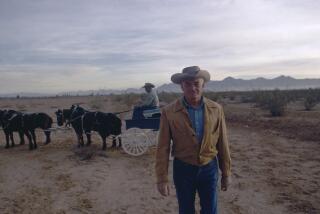Original Cowtown, U.S.A, Now Home of America’s Sleepiest Stockyards
- Share via
FORT WORTH, Tex. — In the old days, when this town was a little less sophisticated and a lot more shameless, cowboys used to gather in Hell’s Half Acre to wager at cards, knock back whiskey and fight over women.
Butch Cassidy and his Hole in the Wall Gang divided the Union Pacific payroll at Fannie Porter’s house of ill repute. Bonnie Parker trysted with Clyde Barrow at the Right Hotel.
Cattle, not cowboys or con men, made possible the vigor of early Fort Worth, just beginning its evolution from a boom town to a mature city with museums, schools and skyscrapers.
The cows, shipped east on 100-car trains, brought in the money and everything else followed. The huge stockyard, largest in the Southwest, symbolized the power of cattle. It stretched across the north end of town from the auction houses to the railroad and gave Fort Worth its nickname, now worn with pride--Cowtown, U.S.A.
Eventually, morality and age caught up with the Hell’s Half Acre part of town and it was steamrollered by developers to make room for a convention center.
Yards Gone to Weeds
But the stockyards remain.
Today the glory of old Fort Worth is trellised across miles of vacant, weedy property. The pens that once poured forth a fortune are empty.
“It’s painful sometimes to look at what remains,” said Elmo Klingenberg, who manages the property for a New York stockyard company and first arrived 50 years ago. “There were years when we ran 4 million sheep and a million cattle through here, plus mules and horses.
“Sometimes I can still hear the whips cracking and men whistling. The dust the animals kicked up was visible for miles. There was nothing like it on Earth.”
But no longer. The Monday morning auction--there is only one each week--is lucky to muster 300 head of cattle or hogs. The offices in the red-tiled exchange house, which once sheltered 50 livestock dealers, now house just one.
“We’re a victim of natural evolution,” Klingenberg said. “I doubt that old way will never be again.”
Hampton Butler, the lone livestock broker, thinks Texas ranchers have simply forgotten the Fort Worth market.
Encircled by Building
“Through the years developments have cropped up all around . . . new homes, new businesses, big highways,” he said. “People forget what was back in here. I’m always having to tell people that the stockyards are still open, still ready for business.”
That business took a hard knock last month, when the state Agriculture Department dropped the Fort Worth Stockyards from its Livestock Market News Services List, a key price index for ranchers nationwide.
“We looked at all the markets and Fort Worth was just no longer able to cut it,” said Gary Miller, of the state agency. “It’s the law of supply and demand.”
The stockyards were built to meet a crushing demand shortly after 1876, the year the Texas and Pacific Railroad’s tracks reached the city, already a major stopover on the Chisholm Trail. By then the yards were shipping more than 2,200 rail cars full of cattle each year.
“In those days, the cattlemen brought their stock to the buyers, who came from around the country,” said Keith Chapman, executive director of the Texas Livestock Assn., a trade group for auction markets. “Everybody was shipping to Fort Worth or San Antone. That’s where the buyers were. That’s where the feedlots or slaughterhouses were.”
Sales Became Localized
In the 1960s, auctions began to be decentralized.
“Ranchers began to feel it was easier for a few buyers to come to them, rather than for them to ship thousands of cattle to the buyers.”
Auctions blossomed in little communities such as Haskell and Pilot Point and Weatherford, and they were soon drawing more business, on average, than the old exchange in Fort Worth.
“A major factor was traffic,” said Steve Munday of the Texas and Southwest Cattle Raisers Assn., the nation’s largest cattlemen’s group. “Why should ranchers drive hundreds of miles and buck the rush-hour traffic when they can haul cattle to an auction house a few miles up the road, no hassle, and get the same price?”
Technology also has changed the market. Today, buyers can purchase large-lot herds at auction via satellite, even videotapes.
Bad publicity has also hurt the stockyards.
A few years back, a group of local investors led by Billy Bob Barnett, who ran the largest honky-tonk in the nation on one edge of the stockyard grounds, promised to make repairs and bring in tourists if the city granted a raft of tax breaks and management of the property. The city went along with the plan, but few repairs were made before Billy Bob’s nightclub and his investor group, Stockyards ‘85, went bust, a victim of the oil price slump and poor management.
The stockyards were returned to the custodial care of a New York management group and Klingenberg, the old-timer, was called out of retirement to take charge.
There is little left to manage. The fence railings are splintered and weathered. The ancient, rusted catwalks are near collapse.
“She’s like a good-looking woman who’s gotten too far past her prime,” Butler said. “Her high-strutting days will never return.”
More to Read
Sign up for The Wild
We’ll help you find the best places to hike, bike and run, as well as the perfect silent spots for meditation and yoga.
You may occasionally receive promotional content from the Los Angeles Times.






